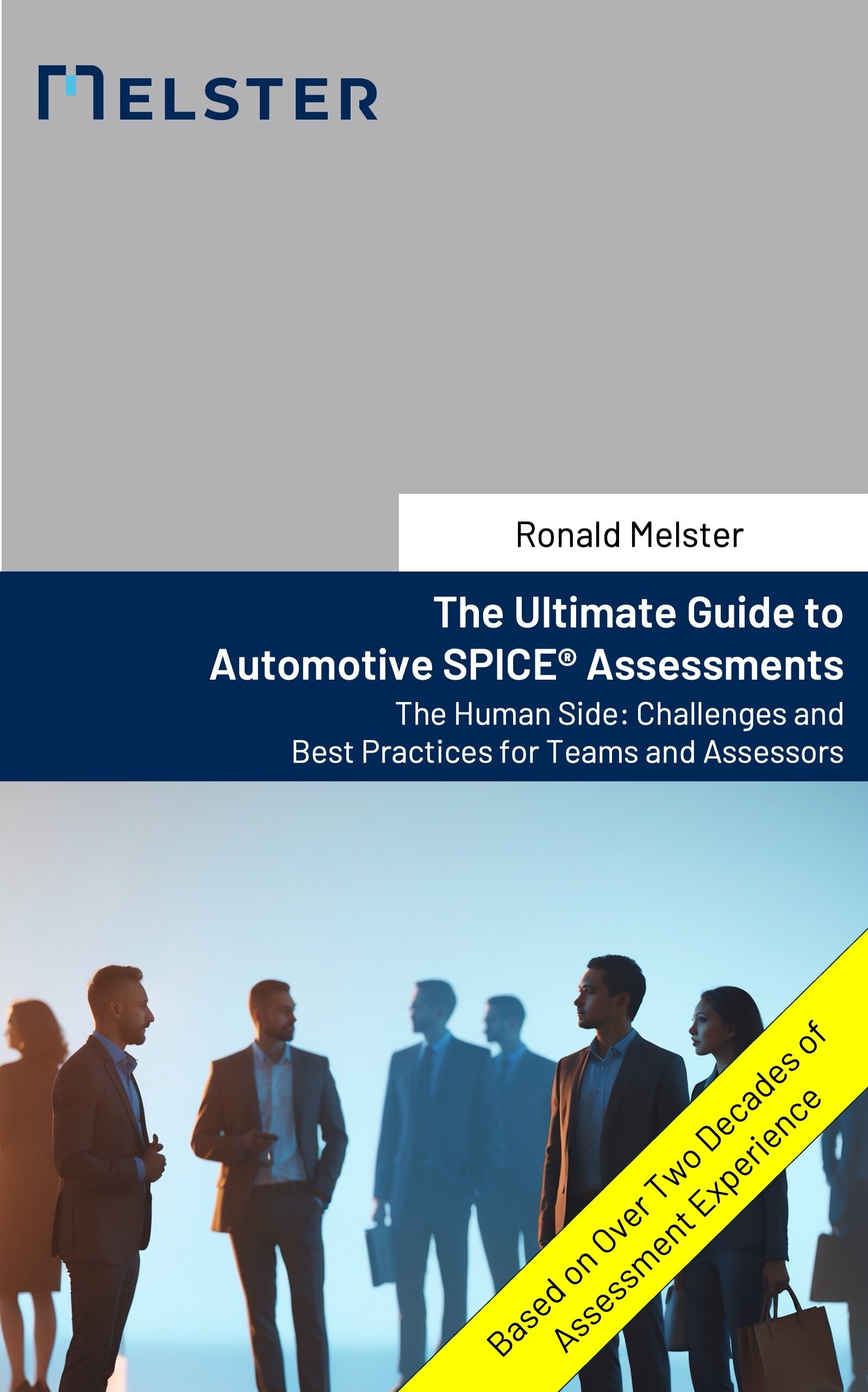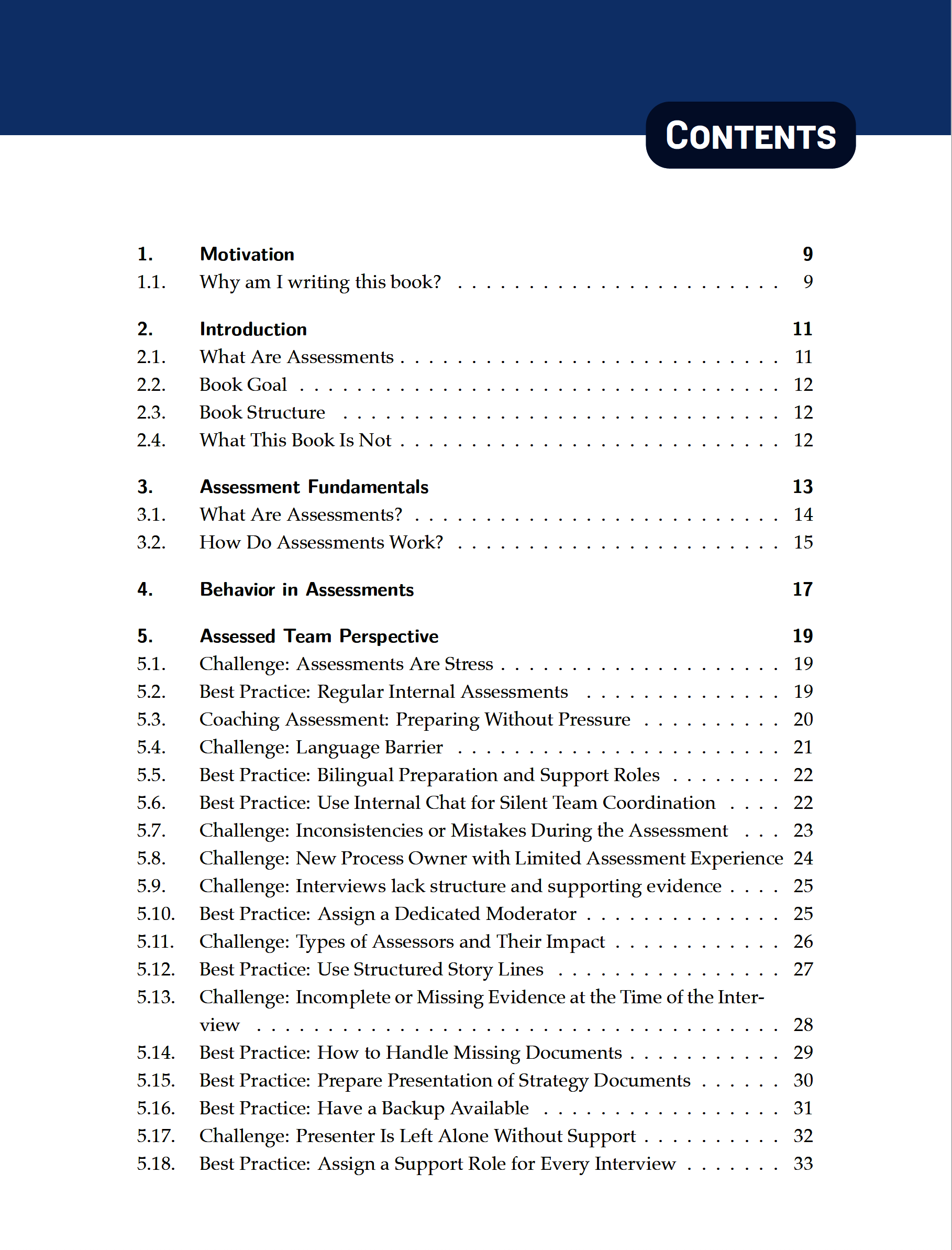The Ultimate Guide to Automotive SPICE Assessments
The Human Side: Challenges and Best Practices for Teams and Assessors
Professional assessment management instead of checklist compliance
This book does not focus on passing assessments, but rather on handling them professionally. It addresses the human side of ASPICE assessments and offers concrete structures, examples, and best practices for assessed teams and assessors.
What makes this book special?
- Practical perspective: Focus on the human side of assessments rather than theoretical models or checklists.
- Dual perspective: Addresses both the challenges faced by the teams being assessed and those faced by the assessors.
- Concrete structures: Offers proven methods, communication strategies, and behavioral guidelines for assessment situations.
- Proven best practices: Based on decades of experience in conducting and supporting ASPICE assessments.
- Professional approach: Focuses not on mere passing, but on the professional conduct of assessments.
- From an experienced lead assessor: Ronald Melster shares his expert knowledge from two decades as an ASPICE assessor in the automotive industry.
Book details
- Author: Ronald Melster
- Print edition: 85 pages (A5 format)
- eBook/Kindle: 60 pages (depending on device)
- ISBN: 978-3-9827736-7-4 (print)
- ISBN: 978-3-9827736-8-1 (eBook)
- Publication date: October 2025
- Publisher: Melster Consulting GmbH
- Language: English
Available formats
| Format | Price | Region | Order |
|---|---|---|---|
| Print (Amazon) | ~EUR 49 | Worldwide | Order on Amazon |
| Print (BoD.de, DACH only) | EUR 49 | DACH | Coming soon |
| Kindle eBook | ~EUR 35 (may vary by region) | Worldwide | Order on Amazon |
| PDF (with watermark, Community Edition) | EUR 20 | Worldwide | Buy on Stripe |
Choose the format and ordering method that best suits your needs.
Who is this book for?
This book is aimed at:
- Engineers and teams preparing for ASPICE assessments
- Project managers and process owners
- Quality assurance professionals who support their teams during assessments
- Assessors and prospective assessors who want to conduct professional assessments
What will you learn?
The book shares best practices for ASPICE assessments based on 20 years of experience as a lead assessor and coach. It shows how to handle assessment situations professionally.
- Structured preparation and conduct of assessment interviews
- Proven communication strategies for both sides of the assessment table
- Solutions for typical challenges in assessment situations
- Professional conduct and expectation management for teams and assessors
1. Motivation (Page 9)
- Why am I writing this book?
2. Introduction (Page 11)
- What Are Assessments
- Book Goal
- Book Structure
- What This Book Is Not
3. Assessment Fundamentals (Page 13)
- What Are Assessments?
- How Do Assessments Work?
4. Behavior in Assessments (Page 17)
5. Assessed Team Perspective (Page 19)
- Challenge: Assessments Are Stress
- Best Practice: Regular Internal Assessments
- Coaching Assessment: Preparing Without Pressure
- Challenge: Language Barrier
- Best Practice: Bilingual Preparation and Support Roles
- Best Practice: Use Internal Chat for Silent Team Coordination
- Challenge: Inconsistencies or Mistakes During the Assessment
- Challenge: New Process Owner with Limited Assessment Experience
- Challenge: Interviews lack structure and supporting evidence
- Best Practice: Assign a Dedicated Moderator
- Challenge: Types of Assessors and Their Impact
- Best Practice: Use Structured Story Lines
- Challenge: Incomplete or Missing Evidence at the Time of the Interview
- Best Practice: How to Handle Missing Documents
- Best Practice: Prepare Presentation of Strategy Documents
- Best Practice: Have a Backup Available
- Challenge: Presenter Is Left Alone Without Support
- Best Practice: Assign a Support Role for Every Interview
6. Assessor Perspective (Page 35)
- Challenge: Limited Time
- Challenge: Limited Sample Scope
- Best Practice: Have Good Moderation Skills
- Best Practice: Limit the Number of Examples
- Best Practice: Offer a Third Example When the Second One Fails
- Best Practice: Overrun the Time in Agreement with the Assessed Organization
- Best Practice: Perform a Kick-Off Meeting with the Team or Organization
- Best Practice: Introduction Round
- Best Practice: Open Questions
- Best Practice: Summarize
- Best Practice: One Question at a Time
- Best Practice: Closing Questions for Completeness
- Best Practice: Internal Assessor Chat
- Best Practice: Use Proper Tools for Assessment Documentation
- Example: Assessment Tool Implementation
- Best Practice: Agree on Roles in the Assessment Team
- Best Practice: Co-Assessor Can Lead the Interviews
7. About the Author (Page 57)
A. List of Best Practices (Page 59)

